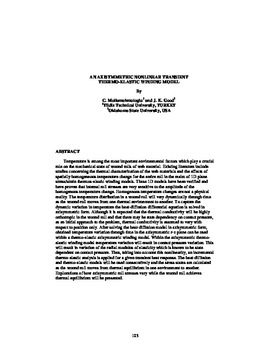| dc.contributor.author | Mollamahmutoglu, C. | |
| dc.contributor.author | Good, J. K. | |
| dc.contributor.other | International Conference on Web Handling (2015) | |
| dc.date.accessioned | 2019-11-12T17:30:10Z | |
| dc.date.available | 2019-11-12T17:30:10Z | |
| dc.date.issued | 2015-06 | |
| dc.identifier | oksd_icwh_2015_mollamahmutoglu2 | |
| dc.identifier.citation | Mollamahmutoglu, C., & Good, J. K. (2015, June). An axisymmetric nonlinear transient thermo-elastic winding model. Paper presented at the Thirteenth International Conference on Web Handling (IWEB), Stillwater, OK. | |
| dc.identifier.uri | https://hdl.handle.net/11244/322036 | |
| dc.description.abstract | Temperature is among the most important environmental factors which play a crucial role on the mechanical state of wound rolls of web material. Existing literature include studies concerning the thermal characterization of the web materials and the effects of spatially homogeneous temperature change for the entire roll in the realm of 1D plane stress/strain thermos-elastic winding models. These 1D models have been verified and have proven that internal roll stresses are very sensitive to the amplitude of the homogenous temperature change. Homogenous temperature changes are not a physical reality. The temperature distribution in a wound roll will vary dynamically through time as the wound roll moves from one thermal environment to another. To capture the dynamic variation in temperature the heat-diffusion differential equation is solved in axisymmetric form. Although it is expected that the thermal conductivity will be highly orthotropic in the wound roll and that there may be state dependency on contact pressure, as an initial approach to the problem, thermal conductivity is assumed to vary with respect to position only. After solving the heat-diffusion model in axisymmetric form, obtained temperature variation through time in the axisymmetric r-z plane can be used within a thermo-elastic axisymmetric winding model. Within the axisymmetric thermoelastic winding model temperature variation will result in contact pressure variation. This will result in variation of the radial modulus of elasticity which is known to be state dependent on contact pressure. Thus, taking into account this nonlinearity, an incremental thermo-elastic analysis is applied for a given transient heat response. The heat-diffusion and thermo-elastic models will be used consecutively and the stress states are calculated as the wound roll moves from thermal equilibrium in one environment to another. Explorations of how axisymmetric roll stresses vary while the wound roll achieves thermal equilibrium will be presented. | |
| dc.format | application/pdf | |
| dc.language | en_US | |
| dc.publisher | Oklahoma State University | |
| dc.rights | In the Oklahoma State University Library's institutional repository this paper is made available through the open access principles and the terms of agreement/consent between the author(s) and the publisher. The permission policy on the use, reproduction or distribution of the article falls under fair use for educational, scholarship, and research purposes. Contact Digital Resources and Discovery Services at lib-dls@okstate.edu or 405-744-9161 for further information. | |
| dc.title | Axisymmetric nonlinear transient thermo-elastic winding model | |
| osu.filename | oksd_icwh_2015_mollamahmutoglu2.pdf | |
| dc.description.department | Mechanical and Aerospace Engineering | |
| dc.type.genre | Conference proceedings | |
| dc.type.material | Text | |
